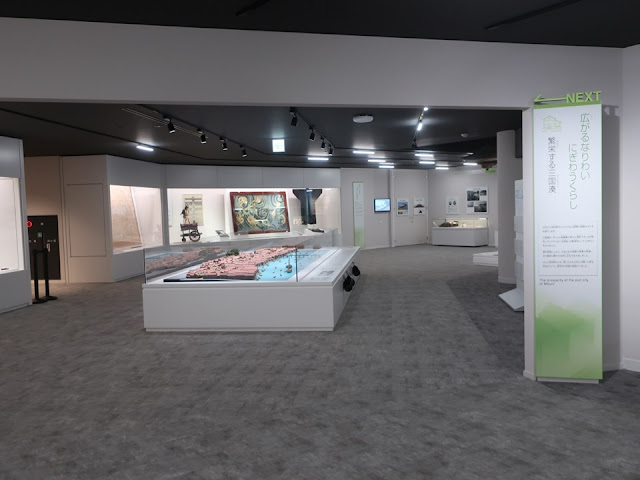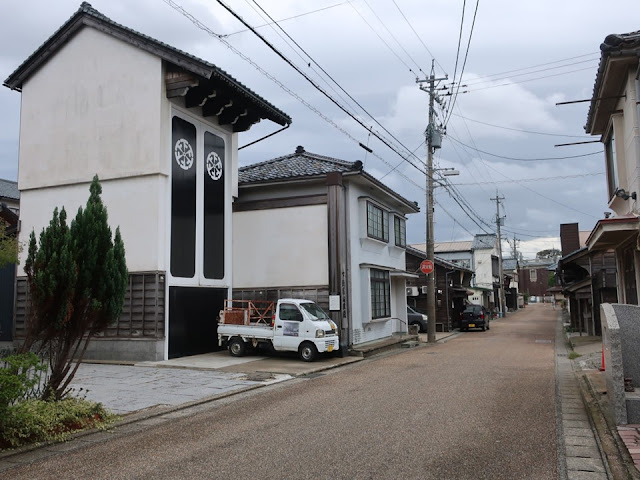The museum is in Sakai City (Fukui
prefecture in central Japan) which has a port “Mikuni-minato”. The port
prospered in the Edo period (1603~1868) as a maritime traffic center of the Japan Sea. Composing poems such as haiku were popular among towners
back then; there was a prostitute who created fine poems. Although it is a calm
town at present, Mikuni festival is so gorgeous even until now. If a town
flourished, everyday would be a festive day.
福井県坂井市の三国湊にある博物館です。三国湊は、江戸時代・明治時代には海運の拠点として大いに栄えましたが、今は静かな町です。かつては、俳句などの詩作が流行し、名作を残す遊女も現れました。一方、三国祭りは今も華やかです。繁栄している時は、毎日がハレの日ですね。
The museum on the left and Mikuni-minato (port) at the river mouth. The museum imitated an elementary school built in 1879 by the donation of towners (the actual one was demolished in 1914). It tells us how prosperous the town was. Sorry for the reflection of the glass window.
博物館(左)と河口の三国の町。博物館は住民の資金で1879年に建てられた龍翔小学校を模した建物です(小学校は1914年に解体)。湊町の財力を感じます。ガラス越しの撮影で映り込みがありありすみません。
The 1/5 scale model of Bezai-sen, which was cargo liner sailed the Japan Sea, is set at the entrance hall. The materials are same as actual ship such as zelkova tree.
ホールには、日本海の輸送船・ベザイ船(北前船)の1/5モデルが展示されています。実物と同じケヤキなどが用いられています。
Many liners were operated, didn’t they? The carried-out items were rice, rapeseed and so on. fish(herring) fertilizer, salt of western Japan (Mitajiri) and so on were carried in.
たくさんのベザイ船が航行していたのですね。1878年に三国で積み込んだ品の第一位は米、二位は菜種でした。持ち込んだ品は、一位が胴鯡(鰊の肥料にする部分)、二位が三田尻塩でした。
Rivers in Fukui flows into Mikuni port. Products had been transported to Mikuni and had been shipped since the ancient are.
福井の川は、九頭竜川に合流して三国に集まります。福井の物品は荘園時代から、三国に来たのですね。
The prosperity of the port city of Mikuni、繁栄する三国湊
Mikuni town was long and narrow. The 1/100 scale model is Mikuni in around 1877. There are big liners and small boats which carry goods at the river.
三国湊は細長い街です(1877年ごろの1/100モデル)。大きな船とともに、荷揚げや荷下ろしを行う小さな船が行き来しています。
The merchant houses of Mikuni are bit different from the other areas; those are called kagura-style. It is unclear why such style is popular here. Anyway, it seems to be luxurious.
他の地方にはない「かぐら建て」が三国の町屋の特徴です。なぜかは分からないのですが、破風のようで、豪華に見えますね。
The exhibition case is named “Flourish culture and ladies”.
It is written, “The prosperity of Mikuni nurtured gorgeous culture of towners. Mikuni festival and the entertainment district shows us Mikuni’s bustle, too.” and “On the other hand, villagers near Mikuni worked as sailormen and women took charge during husband’s absence; wives worked hard to dive fishing and to make durable and decorative clothes called sashiko.”
Although women worked constantly, men worked as sailormen and spent their earnings dynamically at the entertainment district, I just guess. The exhibit in center was a prostitute’s robe worn over a kimono. The fang of the embroidered dragon is ivory.
「華やぐ文化と女性たち」と題した展示ケースがあります。
「湊の繁栄は、華やかな町人文化を育みました。そのにぎわいは、山王宮(三國神社)の祭り(三国祭)や、遊女や芸者が集う花街にもみることができます」「他方、湊周辺の浦方(漁村)も海運業に携わりました。浦の女性たちは船乗りとして航海に出る男たちの留守を預かり、海女漁や着物の刺し子(傷みやすい着物の補強と装飾のための刺繍)の手仕事に励みました」と書かれています。
[2025年7月追記] 昭和の中頃に途絶えていた刺し子を坂野上百恵さん(53)が復活させました。彼女は緻密で単調な刺し子作りは「安全に帰ってきてほしい、無事帰ってきて欲しいっていう女の気持ち」「そんなのを考えたら祈りの刺し子かな」と思うそうです(『小さな旅 君ゆく海~福井県坂井市安島』、NHK、2025年7月20日放送)。
それはそれとして、船乗りたちは、稼いだ金を、花街で一気に使ったのでしょうね。分かります。遊女の打掛の竜の牙は象牙です。
The wealth of Mikuni was also toward to crafts. Buddhist alter is one of them; it is same in Takaoka city at the Japan Sea coast. It seems that people spend their earning on it and thank to their ancestors.
富は工芸品にも費やされました。その中に、仏壇もあります。日本海沿岸の高岡でも仏壇作りが盛んでした。先祖を敬い感謝する仏壇はお金のかけどころだったようです。
The title of this section is “Word play, with which Sakai people familiar”.
A master (selector) showed a theme, then each member made a short poem. The theme within the white dashed line is “that’s right, that’s right”. Someone made a poem, “Noodle, girl, bamboo shoot. Before growing.” Saying that younger girls are better, would cause issue at present, however, I like poets' forgivingness.
「越前・坂井の人びとが親しんだ言葉遊び『雑俳』」と題したコーナーです。
選者のお題に答える形で句を投じて競います。枠線内は、お題「いかさま いかさま」(その通り、その通り)に対して、投句が「うど うどん 娘 竹の子 のびぬうち」(うども、うどんも、娘も、竹の子も成長しないうちが良い)でした。今ならアウトですね。大らかに楽しみましょう。
The table above was made in 1734 and was owned by a poet group “Hiyoriyama-ginsya”. The view of a famous tourist spot was drawn on it. It was also a table to put created poem on it. It’s a gift from a famous poet (Rogenbou, 1688-1747).
有力商人たちが歌会を催した「日和山吟社」の二見文台(1734年)。伊勢の二見浦の絵が入ったおしゃれな机ですね。作った歌を載せる台でもあります。当時の有名歌人・廬元坊(1688-1747)が日和山吟社の宗匠に授けたものです。
A short poem written by a prostitute “Kasen” is on the toothpick holder. She was a well-known poet, too. Perhaps the item invited customers to her place.
遊女(三国では小女郎と呼びました)だった哥川(うたがわ)の句が入った楊枝入れ。彼女は歌人として名を馳せました。お店へ行きたくなりますね。
A travel diary of a wealth merchant and also a poet is displayed. He traveled for three months and visited famous places which became themes of poems. He stayed at Edo (old name of Tokyo) for five weeks. He enjoyed meetings with acquaintances or entertainments of the big city, I guess. How do you think?
豪商で歌人の内田惣右衛門の旅日記が紹介されています。3か月あまりをかけて、歌の名所と江戸に訪れました。江戸には5週間の滞在、知人が多かったのか楽しかったのか、どうでしょう。
Four seasons of Sakai、坂井の四季おりおり
Local events, foods and flowers in each season are shown by panels and videos. I felt happy to be born in a country which has four seasons.
四季それぞれの行事や食や花が、パネルと映像で紹介されています。四季がある国に生まれて、本当に良かった。
The 25th of January is the day of Tenjin (deity of scholarship). People pray for the growing of children and their academic achievement. They put a hanging scroll of Tenjin and offer a grilled flounder.
1月25日は天神様の日で、天神様の掛け軸や人形を床の間に飾り、焼ガレイを供えます。子供の成長と学力向上などを願う行事です。焼ガレイを供えるのは鯛より安いからだとか、理由には諸説あるそうです。
Mikuni festival is held in May. The dolls on the festive float are huge. Mikuni people make dolls of legendary heroes for six floats. Surprisingly enough, even the wheel is decorated by mother-of-pearl work(?).
5月に行われる三国祭り。山車の上の人形が巨大です。6台の山車の人形を、毎年、作るのですが、弁慶、義経、曽我五郎がしばしば題材になっています。螺鈿?を施した車輪の装飾にビックリしました。
A storehouse of a float is on the left. I’ll show you an ex-merchant residence on the street in the following article.
左が、町にある山車蔵(下新区山車蔵)です。次の記事では、この通りにある豪商の岸名家を紹介します。蔵の説明板に、「岸名家には日和山吟社の初代宗匠をつとめた岸名作嚢(さくのう)がいた」と書かれていました。三国文化の中心ですね。
Visited
in October, 2023
Official
website: https://ryusho-museum.jp/en/
https://ryusho-museum.jp/ (in Japanese), accessed in April, 2024
Previous post (museum on the old highway
in Nagano prefecture of central Japan): Nagiso-machi Museum in
Tsumago (2/2)、南木曽町博物館(part2)
Next post (merchant house owned by the master of a poet group “Hiyoriyama-ginsya” in the same town): Ex-Kishina residence in Fukui、旧岸名家(福井県)

















Comments
Post a Comment